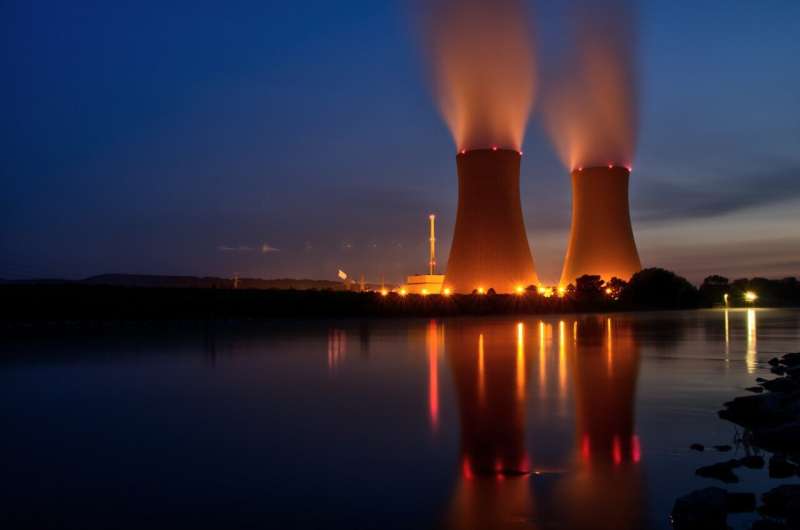
Credit: Pixabay/CC0 Public Domain
From electric cars to artificial intelligence (ai) data centers, the technologies people use every day every day require a growing need for Electricity. In theory, nuclear fusion – a process that fusses atoms together, releasing heat to turn generators – Cold provide vast energy supplies with minimal emissions. But nuclear fussion is an expensive principal one of its main fuels is a rare version of hydrogen called tritium.
Now, Researchers are developing new systems to use nuclear waste to make tritium.
Terence Tarnowsky, A Physicist at Los Alamos National Laboratory (LANL), presented His Results At the fall meeting of the american chemical society (ACS Fall 2025), Held Aug. 17–21.
Today’s Nuclear Power Plants Generate Energy Through a Process Called Nuclear Fission. DURING NUCLEAR FISSION, A Plutonium or Uranium Atom Splits to Release Energy and Particles Called Neutrons, which go on to Split More Atoms. This fission chain reaction provides a steady stream of energy but also results in long-lived nuclear waste.
Proposed Nuclear Fusion Power Plants would generate energy by combining atomic nuclei. With fusion, forms of hydrogen, called deuterium and tritium, would join to create heavier atoms. This process, which powers stars in the universe, release a large amount of energy and, unlike festion, produces very little radioactive waste.
While Deuterium is readily available, the us currently lacques a secure and predictable supply of tritium. “Right now, the value of commercial tritium is about $ 15 million per pound [$33 million per kilogram]And the us does not have any domestic capability to create it, “Says tarnowsky.” So, we have this tritium Supply Shortage. “
Tritium occurs naturally in the upper atmosphere. And the current Major Commercial Source is festion reactors in canada“The total tritium inventory on the planet is about 55 plus or minus 31 pounds [25 plus or minus 14 kilograms]”Says tarnowsky.
“Making some assumptions, 55 pounds [25 kilograms] is enough tritium to power more than 500,000 homes for six months. This is more than the Residential Units in Washington, DC “
Unlike its stores of tritium, the us has Thousands of tons of nuclear waste produced by Commercial Nuclear Power Plants. It contains highly radioactive materials which require expensive storage to keep it safely contained. Long-term storage raises Concerns about radiation leaks into the environment with the potential to harm plants and wildlife, or cause cancer in humans.
So, Tarnowsky Saw An Opportunity to Assess The Feasibility of Using Still-radioactive nuclear waste to generate valuable tritium. He has conducted multiple computer simulations of potential tritium reactors to evaluate the designs’ production and energy efficiency.
The simulated reactor designs use a particle Accelerator to Jump-Start atom-splitting reactions in the nuclear waste. As atoms divide in the simulation, they release neutrons and ultimately produce tritium after a series of other nuclear transitions. The accelerator feature would allow allow operators to turn these reactions on or off and is considered safer than the chain reactions that take place in a typical nuclear power power.
Although the Basic Principles of the Design Are Not New, Advances in Technology Could Make it More Efficient than it was the first considered in the 1990s and early 2000s, say Tarnowsky.
So far, he estimates that this theoretical system running on 1 gigawatt of energy, or the total annual energy needs of 800,000 us homes, Us homes, Cold Propeuce About 4.4 Pounds (2 Kilograms) of TritiM Right. This amount is on par with the total yearly output from all reactors in canada.
A key advantage to tarnowsky’s system would be the efficiency of tritium production. He projects that the design would produce more than 10 times as much tritium as a fusion reactor at the same thermal power.
Next, tarnowsky will generate a dollar cost for tritium production once he has more sophisticated calculations of the reactor’s efficiency. He’ll refine his simulations to more preachisely evaluate the efficiency and safety of the reactor’s design, Most of which have been previously engineered but not sumbine in this way. For example, he plans to develop new code for a model that surrounds the nuclear waste with molten lithium salt, an establesed design for reactors with uranium fuel that haased for Scientific Experiences.
The salt’s cooling properties offer a potential safety measure, and the setup would make it difficult to extract the waste for weapons development. The Ultimate Goal is for the Modeling to Help Decision-Makers Understand which simulation has the most potential for future implementation.
All of this might seem complex, but to tarnowsky its all part of a plan to use existing technology to lower costs. “Energy Transitions are a costly business, and anytime you can make it emier, we should try,” He says.
More information:
On-revamping the fusion economy with kilogram quantities of commercial tritium. Acs.digitellinc.com/p/s/on- ram… RCIAL- Tritium-635641
Citation: Nuclear waste count be a source of future reactors (2025, August 18) retrieved 18 August 2025 from https://techxplore.com/news/2025-08- Nuclear- Source- Fuel- Future-Ractors.html
This document is Subject to copyright. Apart from any Fair Dealing for the purpose of private study or research, no part may be reproduced without the written permission. The content is provided for information purposes only.



